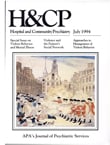The Influence of Social Networks and Social Support on Violence by Persons With Serious Mental Illness
Abstract
The authors examined the relationship between violent acts and threats by persons with serious mental illness, the size and composition of their social networks, and characteristics of the social support they received. Methods: A group of 169 respondents with serious mental illness and 59 of their significant others were interviewed using structured and semi-structured protocols to elicit data on demographic characteristics, clinical characteristics, characteristics of respondents' social networks and of the social support they received, and perceptions of threat within the social network. Data on acts and threats of violence by respondents over an 18-month period were collected from self-reports by respondents and significant others and from hospital and court records. Results: Fifty-six respondents either threatened violence or committed a violent act during the study period. Respondents with a diagnosis of schizophrenia were more likely to commit violent acts but were not more likely to threaten violence than were respondents with other diagnoses. Respondents in larger networks, those with networks composed primarily of relatives, and those who lived with unrelated persons were more likely to threaten violence. Financial dependence on family was associated with more violent threats and acts. Respondents who perceived hostility from others were more likely to engage in violent threats and acts, and those with confused thinking were less likely to act or threaten violence. More than half of the targets of violence were respondents' relatives, particularly mothers living with a respondent. Respondents who were violent perceived their significant others as threatening but did not perceive themselves as being threatening in return. Conclusions: The interpersonal and social contexts of respondents and their perceptions of these contexts are important considerations in assessing risk for violence by persons with mental illness. Mothers who live with an adult offspring with schizophrenia may be at increased risk for being a target of violence. Violence by persons with psychiatric disorders may be linked to their perceptions and experience of being threatened by others. It [living at home] was awful. 1 mean my mother was always drunk. She was screaming and yelling. She never verbally or physically abused me. I mean, I beat my mother up, and that's why people get scared of me. But I didn't know what else to do, and I was so angry at her. I mean, when she got sober I told her one time, I said, ‘I wish to God you'd get drunk.’ And now going to Al-Anon I understand that you're so addicted to the chaos that it's easier to live with. [I told my therapist] I don't like it. It's calm at home. I go home. There's nobody there bothering me.... I don't miss the beating [from current boyfriend]. I miss it being all mixed up and stirredup.
Access content
To read the fulltext, please use one of the options below to sign in or purchase access.- Personal login
- Institutional Login
- Sign in via OpenAthens
- Register for access
-
Please login/register if you wish to pair your device and check access availability.
Not a subscriber?
PsychiatryOnline subscription options offer access to the DSM-5 library, books, journals, CME, and patient resources. This all-in-one virtual library provides psychiatrists and mental health professionals with key resources for diagnosis, treatment, research, and professional development.
Need more help? PsychiatryOnline Customer Service may be reached by emailing [email protected] or by calling 800-368-5777 (in the U.S.) or 703-907-7322 (outside the U.S.).



